OUR PRODUCTS

Pros: A light colored wood giving a distinct appearances, with a soft creamy glow. Wears very well under normal foot traffic. Cons: Difficult to match unity in color of boards especially in lower grades, tending to increase amount of wood needed for job. Difficult to hide nail holes. Color: Heartwood is light tan to dark brown; sapwood is creamy white. Similar to white oak but more yellow. Grain: Bold, straight, moderately open grain with occasional wavy figuring, and can have strong contract in grain in plain-sawn boards. Availability: Moderately available Hardness: Slightly harder than Northern red oak. Durability: Elastic, hard, excellent shock resistance. Workability: Sawing: Good Nailing: Good holding; good resistance to splitting Sanding: Satisfactorily Finishing: Stains well, no known finishing problems.
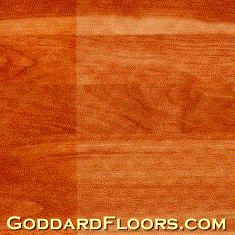
(Fagus grandifolia)
Pros: Beautiful floor with a tight grain can be confused with maple or birch. Very durable. Cons: Boards can vary in color and also include mineral streaks which results in dark sections in the wood. Color: Reddish brown heartwood, with pale white sapwood. Grain: Mostly closed, straight grain, uniform texture. Coarser than European beech. Availability: Limited. Hardness: Slightly harder than Northern red oak. Durability: Elastic, hard; excellent shock resistance. Wears wells, stays smooth when subjected to friction - popular for factory floors. Workability: Sawing: Good with machine tools, difficult to work with hand tools. Nailing: Good holding ability, has tendency to split. Sanding: Satisfactorily finishing: No known problems

Pros: Very tight grained wood similar to Maple with a light and warm appearance. Stains extremely well. Also available in red , which stains even better than the standard white birch. Cons: Can contrast in color from board to board especially in the lower grades. Color: Sapwood is creamy yellow or pale white in yellow birch; heartwood is light reddish brown tinged with red. Sweet birch has light colored sapwood and heartwood is dark brown tinged with red. Grain: Medium figuring, straight, closed grain, even textured. Occasional curly grain or wavy figure in some boards. Availability: Moderately. Hardness: Softer than Northern red oak. Durability: Hard and stiff; very strong. Workability: Sawing: Good machine tools, difficult with hand tools. Nailing: Excellent Sanding: Satisfactorily Finishing: No known problems.
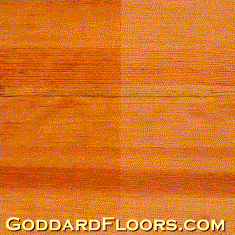
(Pseudotsuga menziesii)
Pros: Grain of wood similar to heart pine. Cons: Very soft, with poor durability. Not recommended for flooring application. Color: Yellowish tan to light brown heartwood. Sapwood is tan to white Heartwood may be confused with that of Southern yellow pine. Radical color change upon exposure to sunlight. Grain: Normally straight, with occasional wavy or spiral texture. Nearly all fir flooring is vertical grain or riftsawn clear grade material. Availability: Readily available Hardness: Softer than Northern red oak Durability: Durable but easily dented. may not be suitable for all flooring applications. Workability: Sawing: Harder to work with hand tools than soft pines. Nailing: Good Sanding: Satisfactorily Finishing: May change color with some finishing products, and care must be taken to avoid over sanding.

(Pinus spp.)
Pros: Only pine that Goddard Floors recommends. Cons: Can be very costly. Color: Heartwood is yellow after cutting and turns deep pinkish tan to warm reddish brown within weeks due to high resin content. Sapwood remains yellow, with occasional blue-black sap stain. Grain: Dense, with high figuring. Plainsawn is swirled; rift or quarter-sawn is primarily pinstriped. Curly or burl grain is rare. Availability: Limited Hardness: Sifter than Northern red oak. Durability: Natural resistance to insects in heartwood; dense. Workability: Sawing: Good Nailing: Good Sanding: Use course paper for 1st sanding, may clog paper. Finishing: Accepts surface and penetrating finishes, some stains tend to blotch.

(Hard/Sugar) (Acer saccharum)
Pros: Great light colored wood with a thigh hard grain. Very suitable for high traffic areas. Cons: Significant expansion and contraction with seasonal changes. Does not except stain well. Color: Heartwood is creamy white to light reddish brown; Sapwood is pale to creamy white. Grain: Closed, subdued grain, with medium figuring and uniform grain texture. Occasionally shows quilted, fiddle back, curly or bird's-eye figuring. Figured boards often culled during grading and sold at a premium. Availability: Commodity item; figured grains limited. Hardness: 12% harder than Northern red oak. Durability: Dense, strong, tough, stiff, often used in bowling alleys and sports floors. Workability: Sawing: Density makes it difficult Nailing: good, fair resistance to splitting Sanding: satisfactorily Finishing: Good in natural finish, DOES NOT stain uniformly.
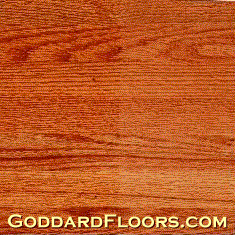
(Red) (Quercus spp.)
Pros: One of the best values for your money. Stains very well. Very durable. Cons: Not very individual. Color: Heart and sapwood are similar with sapwood lighter in color; most pieces have a reddish tone. Slightly redder than white. Grain: Open, slightly coarser (more porous) than white oak. Plainsawn boards have a plumed or flared grain appearance; riftsawn has a tighter grain pattern, low figuring; quarter-sawn has a flake pattern, sometimes called tiger oak, tiger rays or butterflies. Availability: Commodity item available in ALL types, styles and sizes of flooring. Hardness: Stiff & dense, resist wear, less durable than white oak. Workability: Sawing: above average Nailing: good Sanding: satisfactorily, better than white oak Finishing: Strong stain contrast, because of pores.
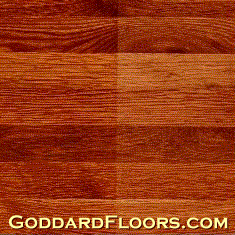
(White) (Quercus alba)
Pros: The best value for your money. Very hard and durable also can be stained in a multiple of colors. Cons: Slightly dark in coloring, can have large contrast in color from board to board especially in the lower grades. Color: Heartwood is light brown; some boards may have a pinkish tint or a slight grayish cast. Sapwood is white to cream. Grain: Open, with longer rays than red oak. Occasional crotches, swirls and burls. Plainsawn boards have a plumed or flared grain appearance; riftsawn has a tighter grain pattern, low figuring; quartersawn has a flake pattern, sometimes called tiger oak, tiger rays, or butterflies. Availability: Commodity item, available in ALL types, styles and sizes of flooring. Hardness: Slightly harder than Northern red oak. Durability: More durable than red oak. Tannic acid in the wood protects it from fungi and insects. Workability: Sawing: good Nailing: good Sanding: satisfactory Finishing: Absorbs finishes more evenly than red oak. Does NOT bleach well.
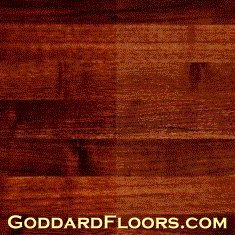
(American Black) (Jaglans nigra)
Pros: Dark rich color with a great durability. Excellent for feature strips in decorative pattern. Cons: Can be expensive. Color: Heartwood ranges from a deep, rich dark brown to a purplish black. Sapwood is nearly white to tan. Difference between heartwood and sapwood is great; some manufacturers steam the wood to bleed the darker heartwood color into the sapwood. Grain: Mostly straight and open, but some boards have burled or curly grain. Availability: Moderately Hardness: 1010 Janka Table, 22% softer than Northern red oak. Durability: Moderately dense, very strong. Workability: Sawing: excellent Nailing: Fair Sanding: satisfactorily Finishing: Nicely.
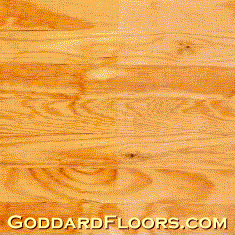
(Southern Yellow) (Pinus spp.)
Pros: Available in wide widths and long lengths Cons Significant expansion and contraction during seasonal changes, can be significantly greater when the boards are wider. Dents and scratches easily. Color: Heartwood varies from light yellow/orange to reddish brown or yellowish brown; sapwood is light tan to yellowish white. Grain: Closed, with high figuring; patterns range from clear to knotty. Hardness: Softer than Northern red oak; longleaf 870 Janka Table, 33% softer than Northern red oak. Durability: Soft, fairly durable, not as resist to scuff, & dents as true hardwoods. Workability: Sawing: good Nailing: good Sanding: Resin tends to clog sand paper, frequent paper changes are required. Finishing: Using durable finishes can help minimize wear.

(Jatoba)
Pros: Can be used over radiant heat very stable with humidity changes. One of the hardest wood floor products. Darkens to a rich deep red. Cons: Difficult to cut due to hardness. Darkens with time. Color: sapwood is gray-white; heartwood is salmon red to orange-brown when fresh, and becomes russet or reddish brown when seasoned; often marked with dark streaks. Grain: Mostly interlocked; texture is medium to rather course. Availability: Readily Hardness: Considerably harder than Northern red oak. Durability: Dense and very strong. Workability: Sawing: Difficult due to high density, carbide tooling recommended. Nailing: Good holding ability; due to hardness may require adjustment of angle of penetration and/or height. Sanding: Well Finishing: No known problems.
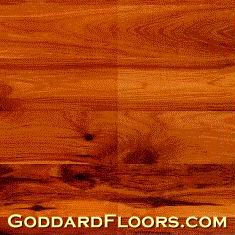
(Callitris glauca)
Pros: Extremely durable, gives a nice rustic look with a warm glow. Cons: Expensive. Color: Sapwood is cream colored; heartwood is honey-gold to brown with darker knots throughout. Grain: Closed Availability: Limited Hardness: Slightly harder than Northern red oak. Durability: Excellent Workability: Sawing: Good Nailing: Can be brittle, splits easily. Sanding: Satisfactorily Finishing: No known problems.
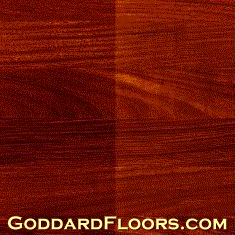
(Santos) (Myroxylon balsamum)
Pros: Very durable flooring, with a nice reddish coloring. Good value for your money Cons: Can have color variations from board to board. Color: Dark reddish brown Grain: Striped figuring in quarter-sawn selections; texture is even and very fine. Availability: Moderately Hardness: Much harder than Northern red oak. Durability: Excellent Workability: Sawing: Moderately difficult to work due to high density, carbide tooling recommended Nailing: Good Sanding: Well Finishing: No known problems.

(Amaranth, Peltogyne spp)
Pros: Deep Purple color great for inlays or borders. Cons: Very expensive. Color: Heartwood is brown when freshly cut, turning to deep purple to purplish brown over time. Sapwood is lighter cream colored. Grain: Straight with medium to fine texture. Availability: Limited Hardness: Harder than Northern red oak. Durability: Very strong and dense. Workability: Sawing: Moderately difficult, carbide tooling recommended. Nailing: Good Sanding: Satisfactorily Finishing: Well, water-based finishes hold color better, has a tendency to bleed in some finishes.
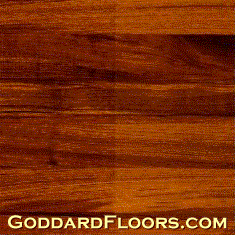
(Thia/Burmese) (Tectona grandis)
Pros: Great for exterior use or near water. Weathers well with or without finish. Cons: Expensive. Color: Heartwood varies from yellow-brown to dark golden brown, turning rich brown when exposed to sunlight. Sapwood is lighter cream colored. Grain: Straight; coarse, uneven texture. Availability: Limited Hardness: Softer than Northern red oak . Durability: Strength values are similar to those of American oak. Workability: Sawing: Moderate ease, carbide tooling recommended. Nailing: Good Sanding: Clogs sanding paper. Finishing: Some finishes have adhesion / drying concerns due to natural oils in the wood.

(Panga-panga, Millettia spp.)
Pros: Great for feature strips. Cons: Limited availability and expensive. Color: Heartwood is yellow-brown when freshly cut,, turning dark brown to almost black with alternate layers of light and dark. Sapwood is yellowish-white and clearly demarcated from heartwood. Grain: Straight when quartered; coarse texture. Availability: Limited Hardness: Quite a bit harder than Northern red oak. Durability: average. Workability: Sawing: Difficult, carbide tooling recommended. Nailing: Good Sanding: Satisfactorily Finishing: Some solvent-based stains do not dry well.

JANKA
